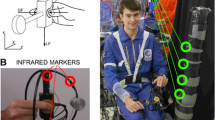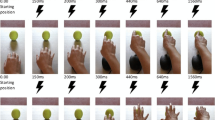Abstract
During movement observation, corticomotor excitability of the observer’s primary motor cortex (M1) is modulated according to the force requirements of the observed action. Here, we explored the time course of observation-induced force encoding. Force-related changes in M1-excitability were assessed by delivering transcranial magnetic stimulations at distinct temporal phases of an observed reach–grasp–lift action. Temporal changes in force-related electromyographic activity were also assessed during active movement execution. In observation conditions in which a heavy object was lifted, M1-excitability was higher compared to conditions in which a light object was lifted. Both during observation and execution, differential force encoding tended to gradually increase from the grasping phase until the late lift phase. Surprisingly, however, during observation, force encoding was already present at the early reach phase: a time point at which no visual cues on the object’s weight were available to the observer. As the observer was aware that the same weight condition was presented repeatedly, this finding may indicate that prior predictions concerning the upcoming weight condition are reflected by M1 excitability. Overall, findings may provide indications that the observer’s motor system represents motor predictions as well as muscular requirements to infer the observed movement goal.


Similar content being viewed by others
References
Aglioti, S. M., Cesari, P., Romani, M., & Urgesi, C. (2008). Action anticipation and motor resonance in elite basketball players. Nature Neuroscience, 11(9), 1109–1116.
Alaerts, K., Heremans, E., Swinnen, S. P., & Wenderoth, N. (2009a). How are observed actions mapped to the observer’s motor system? Influence of posture and perspective. Neuropsychologia, 47(2), 415–422.
Alaerts, K., Senot, P., Swinnen, S. P., Craighero, L., Wenderoth, N., & Fadiga, L. (2010a). Force requirements of observed object lifting are encoded by the observer’s motor system: a TMS study. European Journal of Neuroscience, 31(6), 1144–1153.
Alaerts, K., Swinnen, S. P., & Wenderoth, N. (2009b). Is the human primary motor cortex activated by muscular or direction-dependent features of observed movements? Cortex, 45(10), 1148–1155.
Alaerts, K., Swinnen, S. P., & Wenderoth, N. (2010b). Observing how others lift light or heavy objects: which visual cues mediate the encoding of muscular force in the primary motor cortex? Neuropsychologia, 48(7), 2082–2090.
Avenanti, A., Bolognini, N., Maravita, A., & Aglioti, S. M. (2007). Somatic and motor components of action simulation. Current Biology, 17(24), 2129–2135.
Berner, J., Schonfeldt-Lecuona, C., & Nowak, D. A. (2007). Sensorimotor memory for fingertip forces during object lifting: The role of the primary motor cortex. Neuropsychologia, 45(8), 1931–1938.
Borroni, P., Montagna, M., Cerri, G., & Baldissera, F. (2005). Cyclic time course of motor excitability modulation during the observation of a cyclic hand movement. Brain Research, 1065(1–2), 115–124.
Buccino, G., Binkofski, F., Fink, G. R., Fadiga, L., Fogassi, L., Gallese, V., et al. (2001). Action observation activates premotor and parietal areas in a somatotopic manner: An fMRI study. European Journal of Neuroscience, 13(2), 400–404.
Cattaneo, L., Barchiesi, G., Tabarelli, D., Arfeller, C., Sato, M., & Glenberg, A. M. (2011). One’s motor performance predictably modulates the understanding of others’ actions through adaptation of premotor visuo-motor neurons. Social Cognitive and Affective Neuroscience, 6(3), 301–310.
Chouinard, P. A., Leonard, G., & Paus, T. (2005). Role of the primary motor and dorsal premotor cortices in the anticipation of forces during object lifting. Journal of Neuroscience, 25(9), 2277–2284.
de Haas, Greven and Kilner (2011) Why the motor system is active when observing other people’s actions. Special Issue Psychological Research.
de Lange, F. P., Spronk, M., Willems, R. M., Toni, I., & Bekkering, H. (2008). Complementary systems for understanding action intentions. Current Biology, 18(6), 454–457.
deLange (2011) Why and what do we simulate during the perception of actions?Special Issue Psychological Research.
Devanne, H., Lavoie, B. A., & Capaday, C. (1997). Input–output properties and gain changes in the human corticospinal pathway. Experimental Brain Research, 114(2), 329–338.
Di Pellegrino, G., Fadiga, L., Fogassi, L., Gallese, V., & Rizzolatti, G. (1992). Understanding motor events: a neurophysiological study. Experimental Brain Research, 91(1), 176–180.
Fadiga, L., Fogassi, L., Pavesi, G., & Rizzolatti, G. (1995). Motor facilitation during action observation: a magnetic stimulation study. Journal of Neurophysiology, 73(6), 2608–2611.
Flanagan, J. R., & Johansson, R. S. (2003). Action plans used in action observation. Nature, 424(6950), 769–771.
Fogassi, L., Ferrari, P. F., Gesierich, B., Rozzi, S., Chersi, F., & Rizzolatti, G. (2005). Parietal lobe: From action organization to intention understanding. Science, 308(5722), 662–667.
Gallese, V. (2009). Mirror neurons, embodied simulation, and the neural basis of social identification. Psychoanalytic Dialogues, 19(5), 519–536.
Gallese, V., Fadiga, L., Fogassi, L., & Rizzolatti, G. (1996). Action recognition in the premotor cortex. Brain, 119(2), 593–609.
Gallese, V., Keysers, C., & Rizzolatti, G. (2004). A unifying view of the basis of social cognition. Trends in Cognitive Sciences, 8(9), 396–403.
Gangitano, M., Mottaghy, F. M., & Pascual-Leone, A. (2001). Phase-specific modulation of cortical motor output during movement observation. Neuroreport, 12(7), 1489–1492.
Grafton, S. T., Arbib, M. A., Fadiga, L., & Rizzolatti, G. (1996). Localization of grasp representations in humans by positron emission tomography.2. Observation compared with imagination. Experimental Brain Research, 112(1), 103–111.
Grafton, S. T., & Hamilton, A. F. (2007). Evidence for a distributed hierarchy of action representation in the brain. Human Movement Science, 26(4), 590–616.
Grezes, J., Armony, J. L., Rowe, J., & Passingham, R. E. (2003). Activations related to “mirror” and “canonical” neurones in the human brain: An fMRI study. Neuroimage, 18(4), 928–937.
Hamilton, A., & Grafton, S. T. (2006). Goal representation in human anterior intraparietal sulcus. Journal of Neuroscience, 26(4), 1133–1137.
Hamilton, A. F. D., Joyce, D. W., Flanagan, J. R., Frith, C. D., & Wolpert, D. M. (2007). Kinematic cues in perceptual weight judgement and their origins in box lifting. Psychological Research, 71(1), 13–21.
Hess, C. W., Mills, K. R., & Murray, N. M. (1987). Responses in small hand muscles from magnetic stimulation of the human brain. Journal of Physiology, 388, 397–419.
Iacoboni, M., Woods, R. P., Brass, M., Bekkering, H., Mazziotta, J. C., & Rizzolatti, G. (1999). Cortical mechanisms of human imitation. Science, 286(5449), 2526–2528.
Jeannerod, M. (2001). Neural simulation of action: A unifying mechanism for motor cognition. Neuroimage, 14((1 Pt 2)), S103–S109.
Johansson, R. S., & Westling, G. (1988). Coordinated isometric muscle commands adequately and erroneously programmed for the weight during lifting task with precision grip. Experimental Brain Research, 71(1), 59–71.
Kilner, J. M., Friston, K. J., & Frith, C. D. (2007). The mirror-neuron system: A Bayesian perspective. Neuroreport, 18(6), 619–623.
Kilner, J. M., & Frith, C. D. (2007). A possible role for primary motor cortex during action observation. Proceedings of the National Academy of Sciences USA, 104(21), 8683–8684.
Kilner, J. M., Vargas, C., Duval, S., Blakemore, S. J., & Sirigu, A. (2004). Motor activation prior to observation of a predicted movement. Nature Neuroscience, 7(12), 1299–1301.
Lepage, J. F., Lortie, M., & Champoux, F. (2008). Action-coding neurons in primary motor cortex: Making sense of M1 activity during action perception. Journal of Neuroscience, 28(9), 1995–1996.
Li, C. S. R., Padoa-Schioppa, C., & Bizzi, E. (2001). Neuronal correlates of motor performance and motor learning in the primary motor cortex of monkeys adapting to an external force field. Neuron, 30(2), 593–607.
Loh, M. N., Kirsch, L., Rothwell, J. C., Lemon, R. N., & Davare, M. (2010). Information about the weight of grasped objects from vision and internal models interacts within the primary motor cortex. Journal of Neuroscience, 30(20), 6984–6990.
Maeda, F., Kleiner-Fisman, G., & Pascual-Leone, A. (2002). Motor facilitation while observing hand actions: Specificity of the effect and role of observer’s orientation. Journal of Neurophysiology, 87(3), 1329–1335.
Montagna, M., Cerri, G., Borroni, P., & Baldissera, F. (2005). Excitability changes in human corticospinal projections to muscles moving hand and fingers while viewing a reaching and grasping action. European Journal of Neuroscience, 22(6), 1513–1520.
Nowak, D. A., Voss, M., Huang, Y. Z., Wolpert, D. M., & Rothwell, J. C. (2005). High-frequency repetitive transcranial magnetic stimulation over the hand area of the primary motor cortex disturbs predictive grip force scaling. European Journal of Neuroscience, 22(9), 2392–2396.
Oldfield, R. C. (1971). The assessment and analysis of handedness: the Edinburgh Inventory. Neuropsychologia, 9(1), 97–113.
Pineda, J. A. (2008). Sensorimotor cortex as a critical component of an ‘extended’ mirror neuron system: Does it solve the development, correspondence, and control problems in mirroring? Behavioral Brain Function, 4, 47.
Pobric, G., & Hamilton, A. F. D. (2006). Action understanding requires the left inferior frontal cortex. Current Biology, 16(5), 524–529.
Rizzolatti, G., Fadiga, L., Gallese, V., & Fogassi, L. (1996). Premotor cortex and the recognition of motor actions. Cognitive Brain Research, 3(2), 131–141.
Rizzolatti, G., Fogassi, L., & Gallese, V. (2001). Neurophysiological mechanisms underlying the understanding and imitation of action. Nature Reviews Neuroscience, 2(9), 661–670.
Rizzolatti, G., & Sinigaglia, C. (2010). The functional role of the parieto-frontal mirror circuit: Interpretations and misinterpretations. Nature Reviews Neuroscience, 11(4), 264–274.
Romani, M., Cesari, P., Urgesi, C., Facchini, S., & Aglioti, S. M. (2005). Motor facilitation of the human cortico-spinal system during observation of bio-mechanically impossible movements. Neuroimage, 26(3), 755–763.
Rossini, P. M., Barker, A. T., Berardelli, A., Caramia, M. D., Caruso, G., Cracco, R. Q., et al. (1994). Noninvasive electrical and magnetic stimulation of the brain, spinal-cord and roots: Basic principles and procedures for routine clinical-application. Report of an IFCN committee. Electroencephalography and Clinical Neurophysiology, 91(2), 79–92.
Schutz-Bosbach, S., & Prinz, W. (2007). Prospective coding in event representation. Cognitive Processing, 8(2), 93–102.
Sinigaglia, C., & Sparaci, L. (2010). Emotions in action through the looking glass. Journal of Analytical Psychology, 55(1), 3–29.
Stadler, Springer, Parkinson, Prinz (2011). Self-other commensurability of movement dynamics affects action prediction. Special Issue Psychological Research.
Strafella, A. P., & Paus, T. (2000). Modulation of cortical excitability during action observation: A transcranial magnetic stimulation study. Neuroreport, 11(10), 2289–2292.
Tkach, D., Reimer, J., & Hatsopoulos, N. G. (2007). Congruent activity during action and action observation in motor cortex. Journal of Neuroscience, 27(48), 13241–13250.
Tunik, E., Rice, N. J., Hamilton, A., & Grafton, S. T. (2007). Beyond grasping: Representation of action in human anterior intraparietal sulcus. Neuroimage, 36(2), 77–86.
Uçar, E., & Wenderoth, N. (2011). Movement observation affects sensorimotor memory when lifting a familiar object. Cortex. doi:10.1016/j.cortex.2011.08.011.
Umilta, M. A., Kohler, E., Gallese, V., Fogassi, L., Fadiga, L., Keysers, C., et al. (2001). I know what you are doing: A neurophysiological study. Neuron, 31(1), 155–165.
Urgesi, C., Candidi, M., Fabbro, F., Romani, M., & Aglioti, S. M. (2006). Motor facilitation during action observation: Topographic mapping of the target muscle and influence of the onlooker’s posture. European Journal of Neuroscience, 23(9), 2522–2530.
Urgesi, C., Maieron, M., Avenanti, A., Tidoni, E., Fabbro, F., & Aglioti, S. M. (2010). Simulating the future of actions in the human corticospinal system. Cerebral Cortex, 20(11), 2511–2521.
Wilson, M., & Knoblich, G. (2005). The case for motor involvement in perceiving conspecifics. Psychological Bulletin, 31(3), 460–473.
Zentgraf, K., Munzert, J., Bischoff, M., & Newman-Norlund, R. D. (2011). Simulation during observation of human actions—theories, empirical studies, applications. Vision Research, 51(8), 827–835.
Acknowledgments
We are grateful to all the subjects who participated in this research and to Ellen Smets for her help in the data assessment process. Support for this study was provided through grants from the Flanders Fund for Scientific Research (FWO projects G.0292.05, G.0577.06 & G.0758.10). KA was supported by an FWO postdoctoral research fellowship grant. This work was also supported by Grant P6/29 from the Interuniversity Attraction Poles program of the Belgian federal government.
Author information
Authors and Affiliations
Corresponding author
Electronic supplementary material
Below is the link to the electronic supplementary material.
Rights and permissions
About this article
Cite this article
Alaerts, K., de Beukelaar, T.T., Swinnen, S.P. et al. Observing how others lift light or heavy objects: time-dependent encoding of grip force in the primary motor cortex. Psychological Research 76, 503–513 (2012). https://doi.org/10.1007/s00426-011-0380-1
Received:
Accepted:
Published:
Issue Date:
DOI: https://doi.org/10.1007/s00426-011-0380-1




